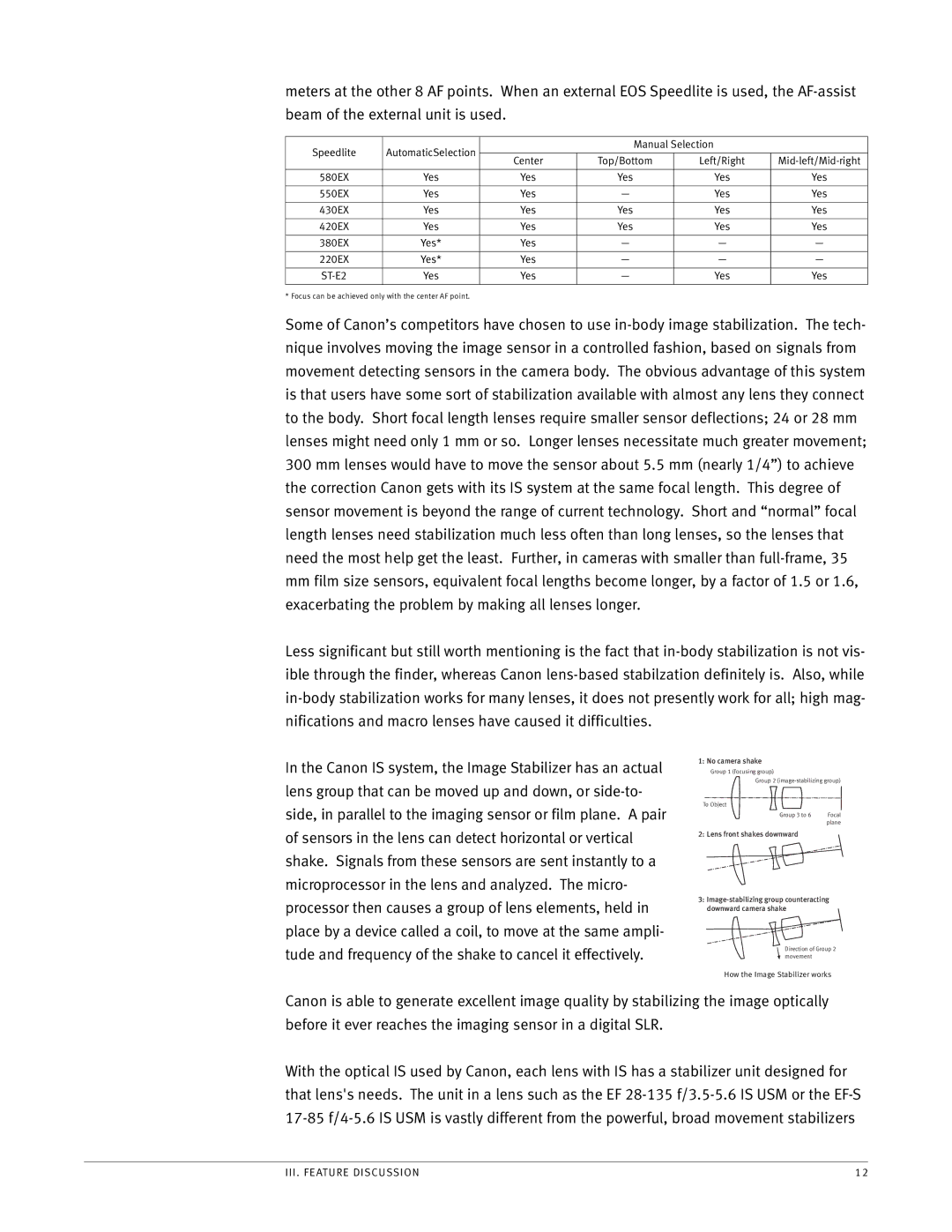
meters at the other 8 AF points. When an external EOS Speedlite is used, the AF-assist
beam of the external unit is used.
Speedlite | AutomaticSelection | | Manual Selection | |
| | | |
| | Center | Top/Bottom | Left/Right | Mid-left/Mid-right |
| | | | | |
580EX | Yes | Yes | Yes | Yes | Yes |
| | | | | |
550EX | Yes | Yes | — | Yes | Yes |
| | | | | |
430EX | Yes | Yes | Yes | Yes | Yes |
| | | | | |
420EX | Yes | Yes | Yes | Yes | Yes |
| | | | | |
380EX | Yes* | Yes | — | — | — |
| | | | | |
220EX | Yes* | Yes | — | — | — |
| | | | | |
ST-E2 | Yes | Yes | — | Yes | Yes |
| | | | | |
* Focus can be achieved only with the center AF point.
Some of Canon’s competitors have chosen to use in-body image stabilization. The tech- nique involves moving the image sensor in a controlled fashion, based on signals from movement detecting sensors in the camera body. The obvious advantage of this system is that users have some sort of stabilization available with almost any lens they connect to the body. Short focal length lenses require smaller sensor deflections; 24 or 28 mm lenses might need only 1 mm or so. Longer lenses necessitate much greater movement; 300 mm lenses would have to move the sensor about 5.5 mm (nearly 1/4”) to achieve the correction Canon gets with its IS system at the same focal length. This degree of sensor movement is beyond the range of current technology. Short and “normal” focal length lenses need stabilization much less often than long lenses, so the lenses that need the most help get the least. Further, in cameras with smaller than full-frame, 35
mmfilm size sensors, equivalent focal lengths become longer, by a factor of 1.5 or 1.6, exacerbating the problem by making all lenses longer.
Less significant but still worth mentioning is the fact that in-body stabilization is not vis- ible through the finder, whereas Canon lens-based stabilzation definitely is. Also, while in-body stabilization works for many lenses, it does not presently work for all; high mag- nifications and macro lenses have caused it difficulties.
In the Canon IS system, the Image Stabilizer has an actual lens group that can be moved up and down, or side-to- side, in parallel to the imaging sensor or film plane. A pair of sensors in the lens can detect horizontal or vertical shake. Signals from these sensors are sent instantly to a microprocessor in the lens and analyzed. The micro- processor then causes a group of lens elements, held in place by a device called a coil, to move at the same ampli- tude and frequency of the shake to cancel it effectively.
1:No camera shake
Group 1 (focusing group)
Group 2 (image-stabilizing group)
To Object
2: Lens front shakes downward
3:Image-stabilizing group counteracting downward camera shake
Direction of Group 2 movement
How the Image Stabilizer works
Canon is able to generate excellent image quality by stabilizing the image optically before it ever reaches the imaging sensor in a digital SLR.
With the optical IS used by Canon, each lens with IS has a stabilizer unit designed for that lens's needs. The unit in a lens such as the EF 28-135 f/3.5-5.6 IS USM or the EF-S 17-85 f/4-5.6 IS USM is vastly different from the powerful, broad movement stabilizers
III. FEATURE DISCUSSION | 12 |

